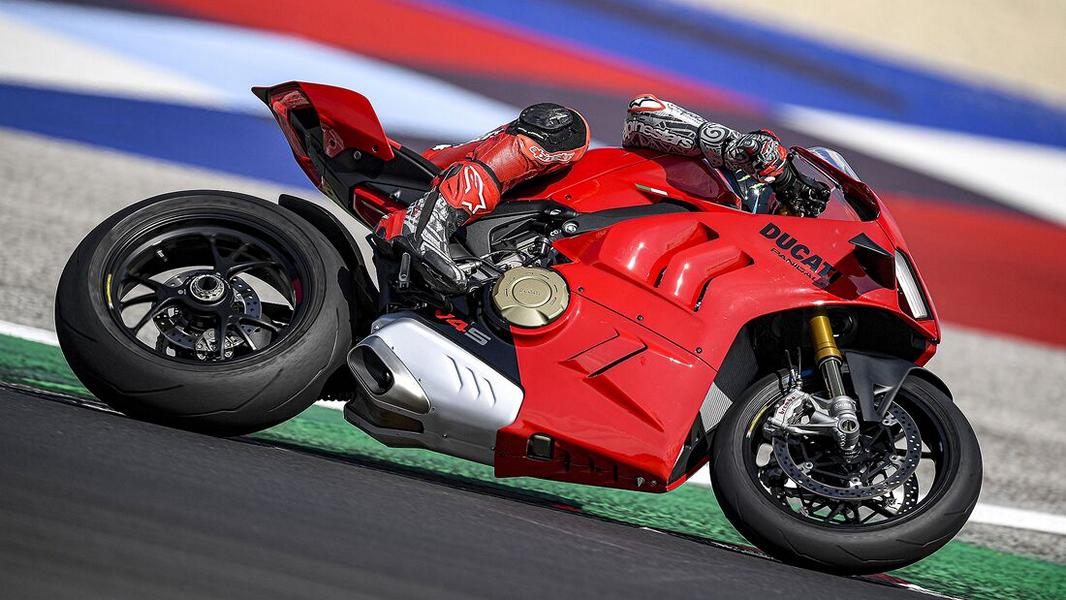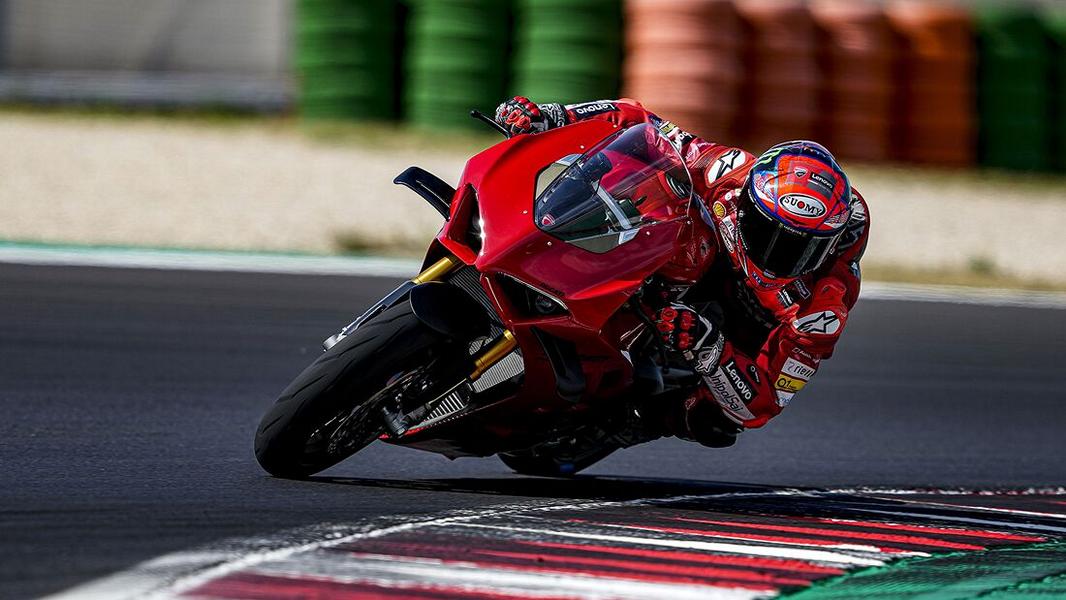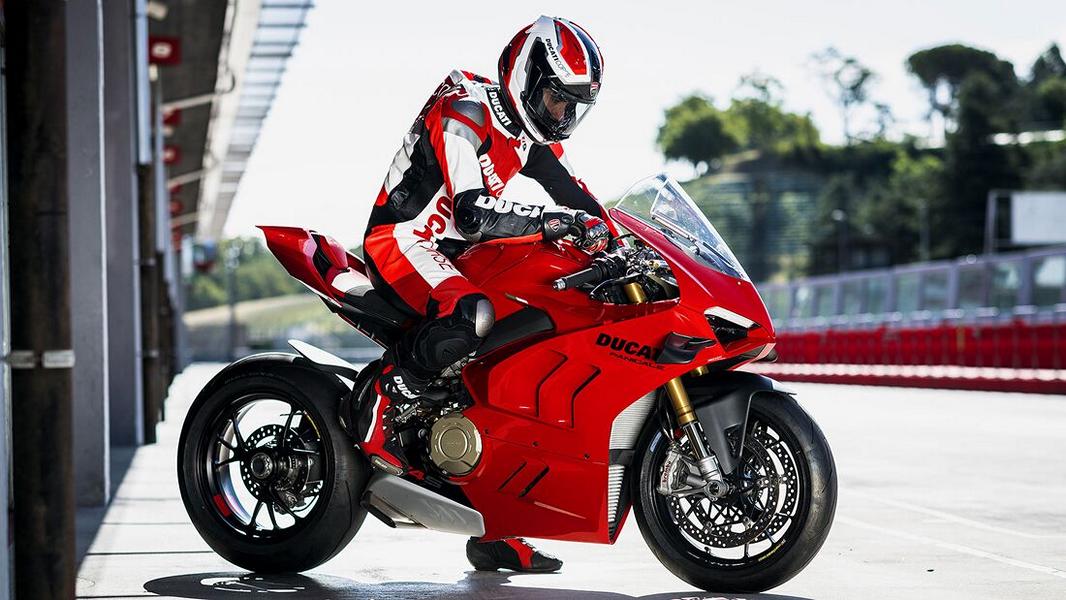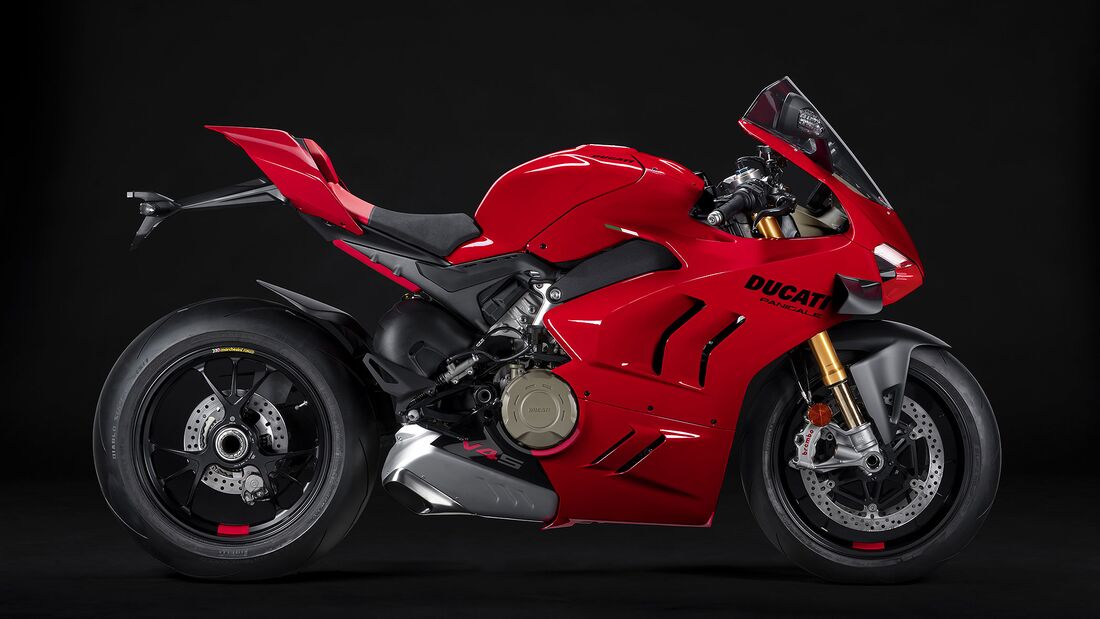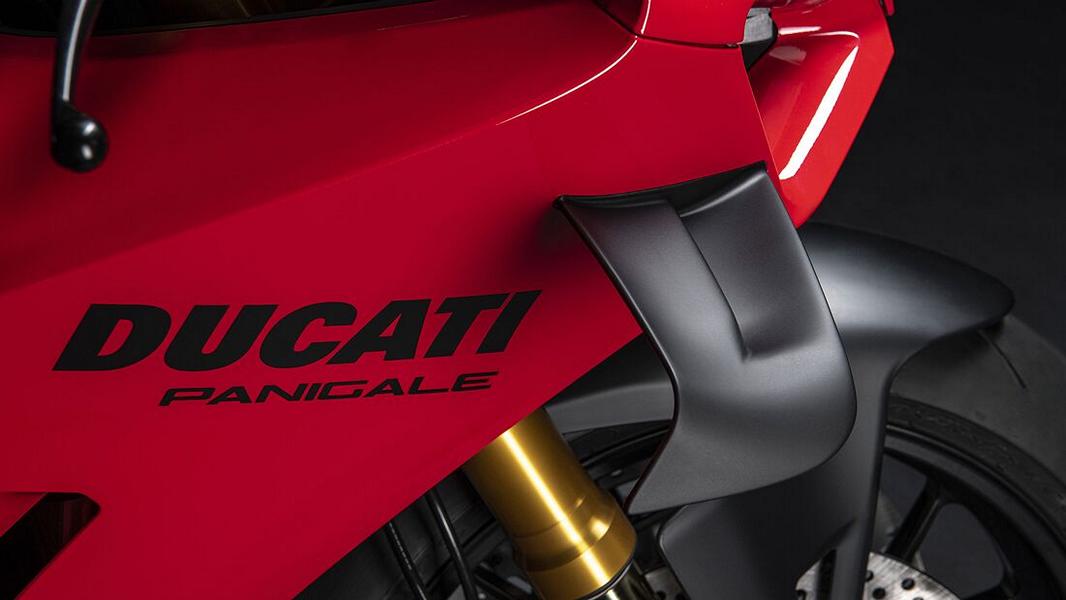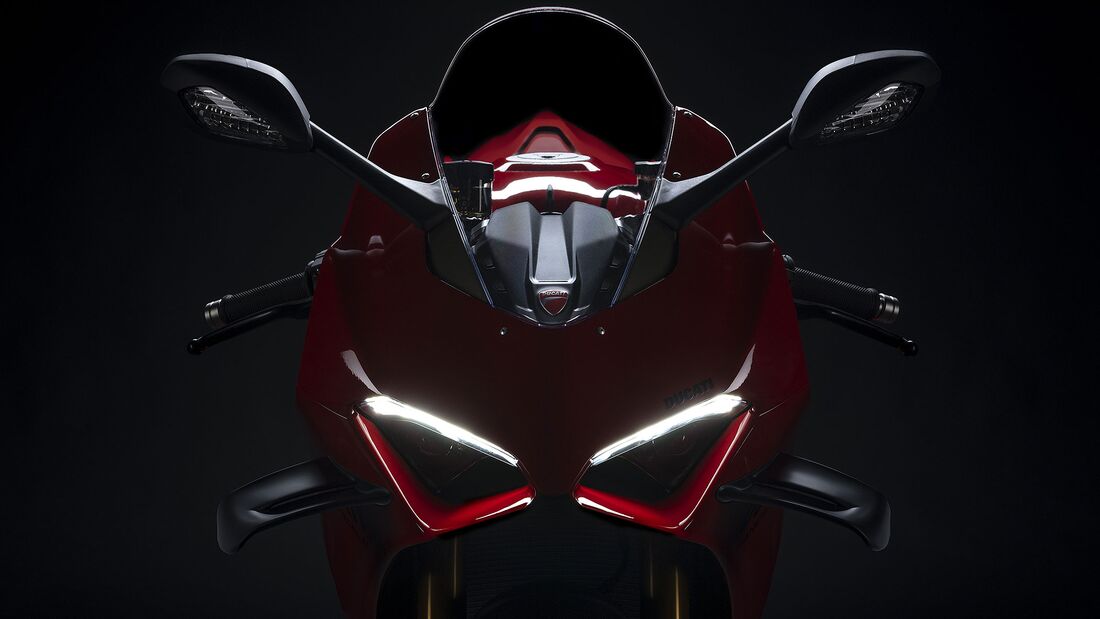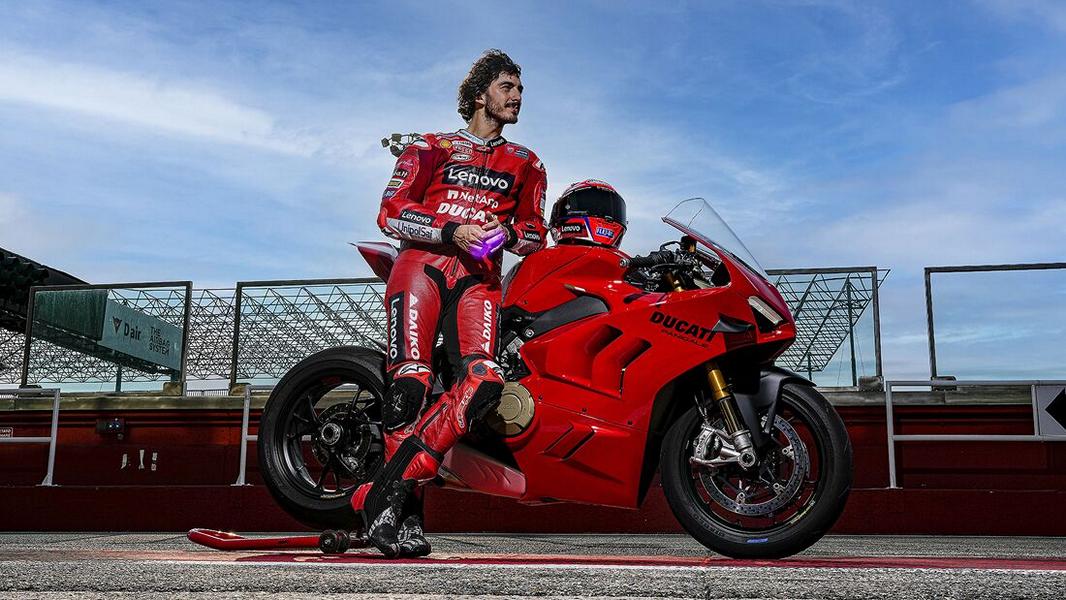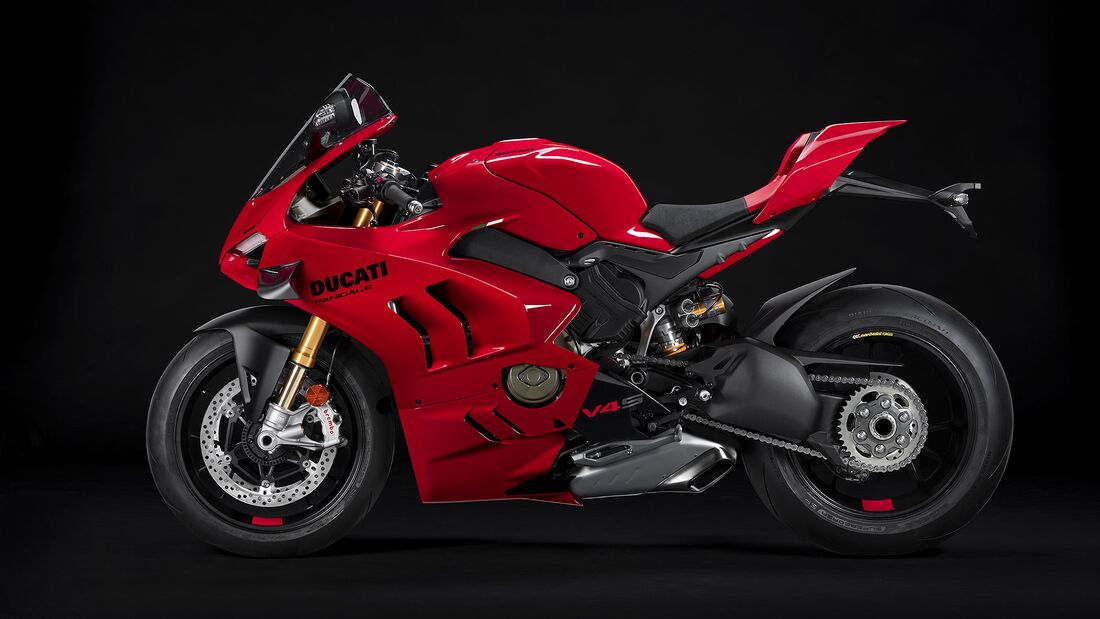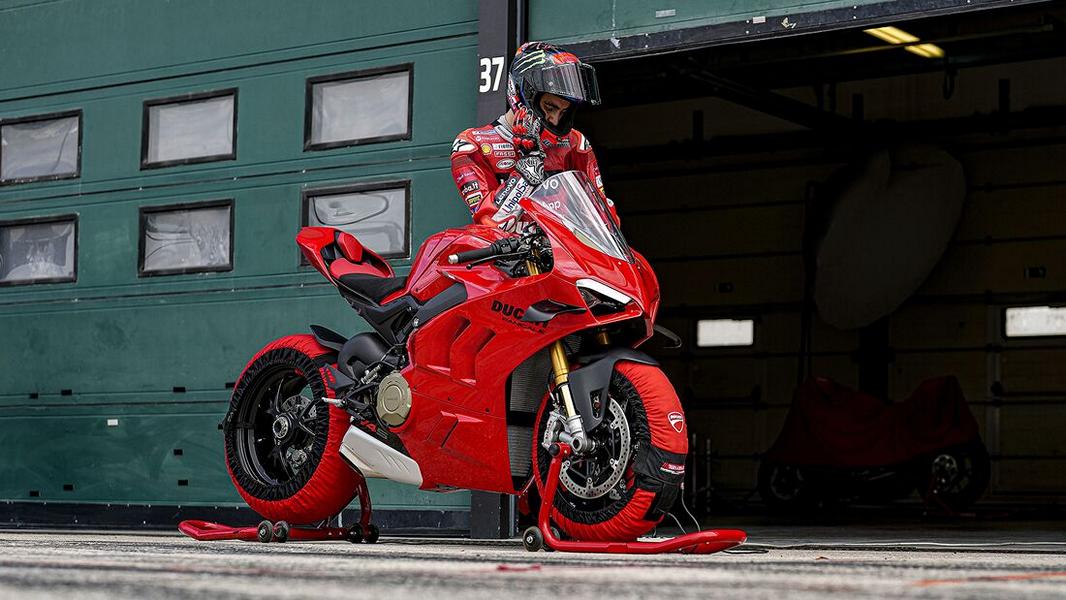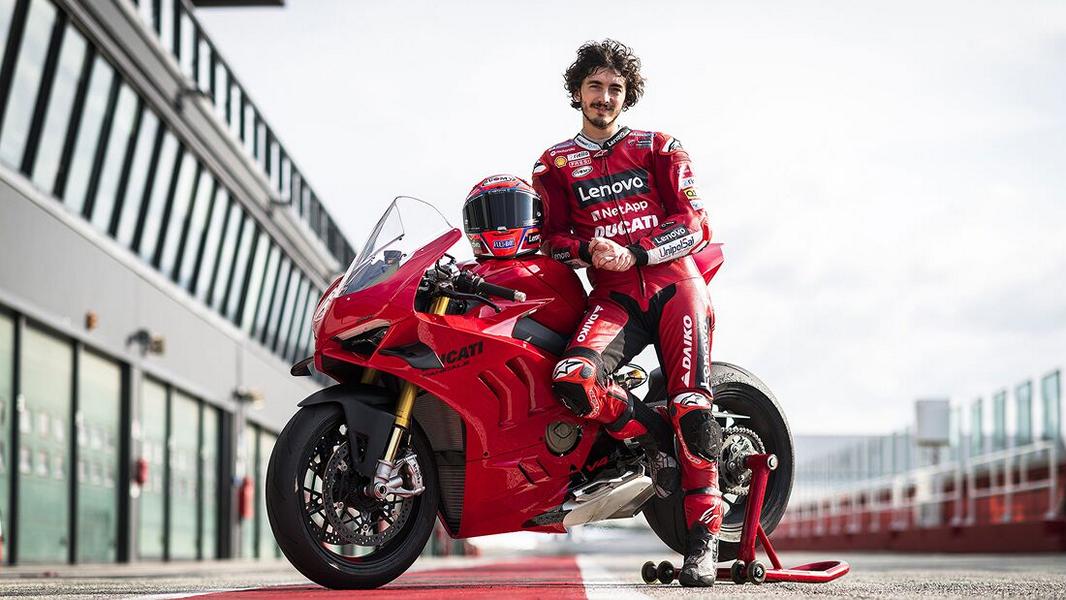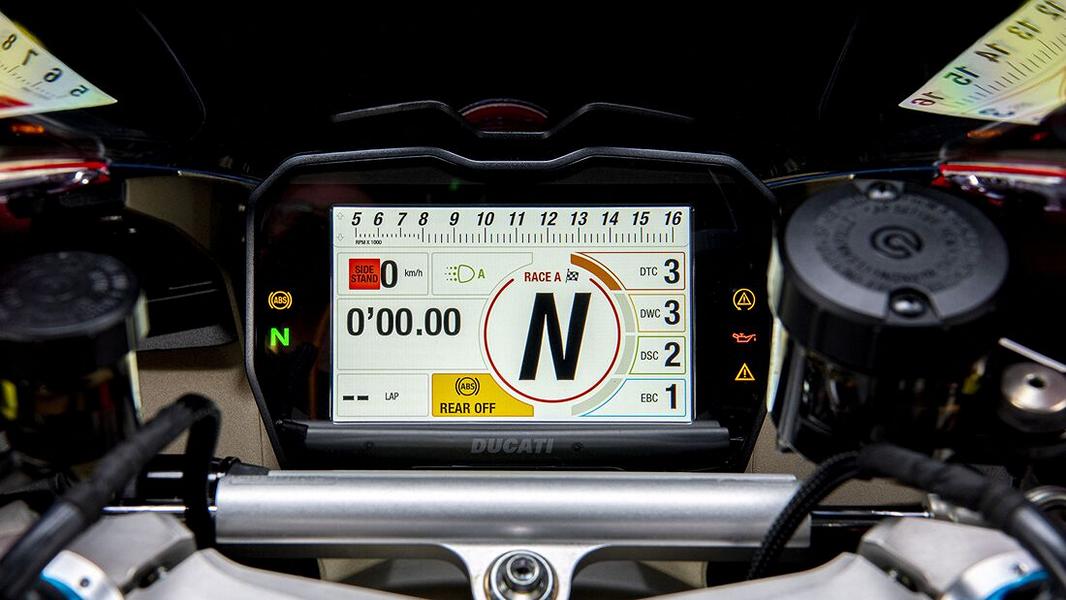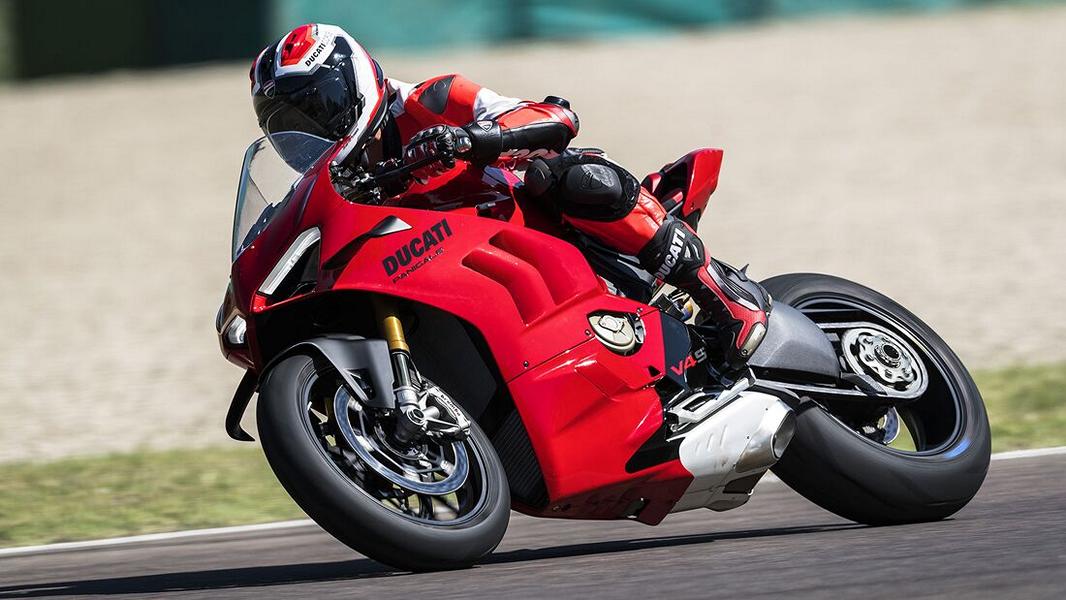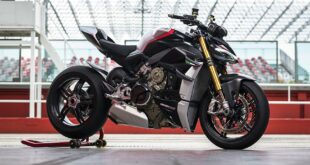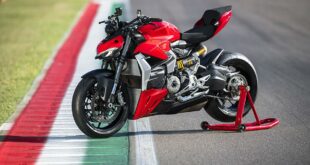The Panigale V4 2022 represents the latest step in the development of Ducati Superbikes. The motorcycle thrives on Ducati Corse's many years of experience and the continuous transfer of knowledge and technologies from the world of racing directly into series production. This new project expresses the uniqueness of the brand, which has won the MotoGP design engineer title for the second time in a row. Every single element developed in racing is carried over to the motorcycles that Ducati builds for its enthusiasts. Because of this, the Panigale V4 is constantly being renewed and improved, just like the motorcycles in MotoGP and WorldSBK.
Ducati Panigale V4 (2022)
With version 2022, the Panigale V4 project completes the most significant development since its inception. The improvements affect all areas: aerodynamics, ergonomics, engine, chassis and electronics. The result is an even faster motorcycle on the racetrack, and at the same time a more intuitive and less tiring motorcycle for a wide variety of riders. In short, it offers a great driving experience for both professionals and amateurs.
These exclusive properties were confirmed by a special test on the Vallelunga circuit in Italy. The Panigale V4 S 2021 and the 2022 version, both of which were fitted with Pirelli SC1 tires, were the focus of the test, which was carried out by two test drivers and professional Michele Pirro (Ducati's official test driver). At the end of the day, the first test driver improved his best lap on the new Panigale V4 S 2022 by 0,9 seconds, the second by 1,2 seconds, while Michele Pirro was half a second faster. He lost just three seconds on his fastest lap time in the first round of the Italian Superbike Championship in Vallelunga. This performance becomes even more impressive when you consider that he used the extra-soft SCX tire for racing, which offers more grip.
The first innovation of the new Panigale V4 2022 version concerns the aerodynamics. The Ducati engineers have concentrated on the fairing, which now has more compact and thinner winglets with a double profile and higher aerodynamic efficiency: This update guarantees the same downforce as before with up to 37 kg at 300 km / h. In addition, the lower part of the fairing has been given newly designed air intakes to improve the cooling system and thus the performance of the engine, especially when used on the racetrack.
Ergonomics was also at the center of development to improve control of the motorcycle on the racetrack and to enable the rider to make the most of the Panigale V4's performance, both on a single lap and during intensive use on the racetrack.
The seat now has a flatter shape and a different cover to give the driver even better braking support and greater freedom of movement. Compared to the version from 2021, the tank has a new shape in the rear part. The driver has more grip when braking and can therefore drive faster and longer. Thanks to this new ergonomics, the rider is fully integrated into the motorcycle. That basically makes driving more pleasant. The contact area of the arms during hanging-off, when the driver leans completely next to the motorcycle, has also been improved. At the heart of the bike is the 1.103cc Desmosedici Stradale, which is descended from the MotoGP engine and has received a number of updates. Thanks to some technical innovations, the performance could be increased further. In addition, the throttle response is now even more direct.
The new engine has been revised in the area of the oil circuit and is equipped with a new oil pump that has a lower power consumption. The enlarged diameter of the silencer outlets enables a reduction in exhaust gas back pressure and thus an increase in engine performance. Thanks to these measures and a new, special mapping, the Desmosedici Stradale - with Euro 5 approval - develops 215,5 hp at 13.000 revolutions per minute. This corresponds to an increase in performance of 1,5 HP compared to the previous engine. At a speed of 14.500 revolutions per minute, the difference is even 2,5 HP. The motor delivers a torque of 123,6 Nm at 9.500 rpm and already provides 6.000% of the maximum torque from 80 rpm.
One detail that says a lot about the development of this new engine for 2022 is the new gear ratio. The first, second and sixth gears are now longer. This new SBK gear ratio is more “racing-oriented” and therefore better suited for use on the racetrack. The first gear was lengthened by 11,6% and the second by 5,6%. Thanks to this new gear ratio, it is now easier to drive through the tightest corners in first gear and benefit from a stronger engine brake and better acceleration out of the corners. In addition, the smaller jump between first and second gear enables the Ducati Quick Shift System (DQS) to shift gears more efficiently and thus improve performance. The DQS has also received a new vote. The sixth gear, which is 1,8% longer, in conjunction with the increased engine output, enables 5 km / h more top speed than the Panigale V4 2021.
In the Panigale V4 2022, a new logic was implemented for the power modes, which enables 4 different motor configurations: Full, High, Medium, Low. The Full and Low configurations have been redesigned, while the High and Medium configurations have been given a new strategy. The Power Mode Full is the sportiest that has ever been used on a Panigale V4. With the exception of first gear, the engine can express its full potential with torque curves without electronic filters. A new mapping management system for ride by wire has been developed for the high and medium performance levels. Each of the six courses has its own mapping. This optimizes propulsion when the driver accelerates. The Power Mode Low, on the other hand, was developed to make driving on the road even more pleasant. It limits the maximum power of the motorcycle to 150 hp and offers a particularly controllable throttle response.
The performance of the Desmosedici Stradale can be further improved thanks to the racing exhaust systems from the Ducati Performance catalog. In order to offer everyone the opportunity to drive with a real racing exhaust even on tracks with stricter noise limits, a new exhaust system is available which is made entirely of titanium, was developed in cooperation with Akrapovič and complies with the noise limit of 105 dB (102 dB with the dB killer). The new exhaust is equipped with high silencers along the rear and provides an increase in power of 12,5 hp, increasing the peak power to 228 hp and the maximum torque to 131 Nm. At the same time, the weight is reduced by 5 kg. This new exhaust is offered in parallel to the more compact complete racing system already available in the catalog, which is placed under the engine and is also made entirely of titanium by Akrapovič. With the same performance values, it reduces the weight by 6 kg and has a noise level of 109 dB, which drops to 107 dB with the dB killer.
The Desmosedici Stradale also serves as a load-bearing element for the chassis and is directly connected to the aluminum front frame. The chassis is completed by the lightweight front frame made of magnesium and the rear frame made of cast aluminum. The new Panigale V4 S is equipped with the new electronically controlled Öhlins NPX 25/30 gas pressure fork, which uses a cartridge derived from the Öhlins racing fork, which minimizes the risk of oil cavitations compared to a conventional fork. The result is improved driving stability when braking and, at the same time, better absorption of bumps, which is reflected in a better driving experience.
The new fork has 125 mm of travel (+5 mm compared to the fork of the Panigale V4 2021). This enables softer adjustments (the spring rate has been reduced from 10,0 to 9,5 N / mm). This leads to a smoother response on uneven surfaces and better grip in poor grip conditions. In addition, the feeling in hard braking zones is improved, which provides additional reserves when racing.
The new fork works in combination with the Öhlins TTX36 shock absorber and the Öhlins steering damper, both of which have dynamic damping changes. This system offers the driver the option of adapting the functionality of the spring elements depending on the driving situation (braking, cornering, acceleration) and changing the hardware parameters. For the driver, this means a greater degree of control over the driving dynamics of the motorcycle, which benefits road safety on the road and lap times on the racetrack. In addition, the pivot point of the aluminum single-sided swing arm is positioned 4 mm higher than on the 2021 version. This technical change increases the anti-squat effect. This means that the rear does not deflect as deeply when accelerating.
The Panigale V4 S is equipped with forged 3-spoke aluminum rims and fitted with Pirelli Diablo ™ Supercorsa SP tires (120/70 ZR17 front and 200/60 ZR 17 rear). The front brake system consists of Brembo Stylema® monoblock brake calipers, each with four pistons, each 30 mm in diameter. In combination with the brake discs with a diameter of 330 mm, this ensures exceptional braking performance. The rear wheel is decelerated by a 245 mm brake disc and a 2-piston brake caliper.
Even the standard version of the Panigale V4 is equipped with a state-of-the-art chassis, which consists of a fully adjustable Showa Big Piston Fork (BPF) with a stanchion diameter of 43 mm, a Sachs steering damper and a fully adjustable Sachs shock absorber, as well as cast aluminum rims in the 5- Spoke design. The Panigale V4 2022 is equipped with a state-of-the-art electronics package based on the use of a 6-axis inertial platform, which is able to immediately record the roll, yaw and pitch angles of the motorcycle in space. The electronic package includes controls for all driving phases, the parameters of which are linked to the 4 available driving modes (Race A, Race B, Sport, Street) as standard.
Thanks to the improved display, these parameters can be shown even more clearly. Some functions are represented by additional signal lights. But that's not all: Ducati technicians have developed an additional information mode. This was created after consultation with the MotoGP riders and is called "Track Evo". This mode is now available alongside Road and Track modes. In "Track Evo" mode, the tachometer moves on a horizontal scale, which is located in the top part of the display. This area can best be seen by the driver. The driver sees the gear engaged in the middle of the screen. On the right side there are four different colored sectors, each assigned to an electronic control (DTC, DWC, DSC, EBC). The respective sector lights up as soon as the electronics intervene. The displays are active until the driver recognizes which electronic aid is activated. This mode makes it easier for the driver to quickly understand which control system actually controlled, so that he can make more precise decisions when looking for the optimal setting. This enables him to improve the motorcycle's performance more quickly. The left area of the display shows the lap time, the number of laps completed and the speed.
In order to better recognize the optimal switching time, a green LED was placed on the top left. This solution improves visibility and provides more precise feedback.
The look of the motorcycle has also been revised and given a further dose of aggressiveness. The unprecedented graphic design, created by Ducati Centro Stile, includes black logos on the completely red trim parts. The seat consists of two materials and is two-tone in the S version. The black wheels of the S version also have red design elements.
The Panigale V4 can be equipped with accessories from the Ducati Performance catalog. The range includes components with approval for road traffic as well as pure racing parts that have been developed for driving on closed-off routes. The Ducati Performance accessories can be viewed using the online configurator at Ducati.com.
In addition to a wide range of accessories, Ducati also offers leather suits (also with an airbag system), helmets, boots and gloves, all of which serve the safety of the driver. Ducati meets the needs of all motorcyclists, from sporty driving on the racetrack to adventures on public roads. For every occasion there is the perfect outfit with which you can dress like a real Ducati driver.
2022 Technical changes
Design
- The Panigale V4 2022 is going through some significant changes that redefine its style and make the bike more aesthetically aggressive. The brand new graphics, designed by Ducati Centro Stile, include black logos on the red panels. The seat is now made of two different materials (two-tone for the S version). In the S version, the black rims also have red design elements.
aerodynamics
- The aggressive look is also reinforced by the changes to the fairing, which has been modified compared to the previous model in order to improve the aerodynamics, based on the continuous updates in MotoGP. In this new version, the motorcycle has more compact and thinner winglets with a double profile and higher aerodynamic efficiency, which guarantee the same downforce as before (up to 37 kg at 300 km / h). The lower part of the fairing is also equipped with additional air intakes to improve the cooling and thus the performance of the engine, especially when used on the racetrack. With the Panigale V4, every detail has a function, such as the small opening on the left-hand side of the panel. This ensures that the Quickshifter's temperatures are kept under control during tough use on the racetrack.
Ergonomics
- Ergonomics has been extensively researched and developed by Ducati engineers in order to improve control of the motorcycle during the most important stages of the journey on the racetrack and to enable the rider to fully utilize the performance of the Panigale V4 even during a long session. The main changes affect the seat and the tank. These components have been redesigned. The seat now has a flatter shape and a cover that is easier to grip. The new shape gives the driver more freedom of movement, while the new cover improves grip when braking. The fuel tank has a new shape that gives it a larger capacity (+1 liter) and improves knee closure compared to the 2021 vintage. Drivers of all sizes can better support themselves on the motorcycle when braking. The result is better lap times over a longer period of time. Thanks to this new ergonomics, the rider is also better integrated into the motorcycle and is therefore in the optimal aerodynamic position. In addition, the contact area of the arms during hanging-off has also been improved.
Motor
- At the heart of the bike is the 1.103cc Desmosedici Stradale, which is descended from the MotoGP engine and has received a number of updates. The Desmosedici Stradale has been revised again for 3, thanks to some technical changes, the performance has been increased and the throttle response has been further improved. The revised engine is connected to a new muffler and a new oil pump. The diameter of the two muffler outlets has been increased to 2022 mm (38% larger exhaust outlet compared to the mufflers on the MY18), which has reduced the back pressure in the exhaust and consequently improves the performance of the engine. The smaller oil pump and the optimization of the oil circuit lead to lower power consumption. Thanks to these modifications and an optimized engine set-up, the maximum output of the Desmosedici Stradale (with Euro 2021 approval) increases by 5 HP and reaches 1,5 HP at 215,5 rpm. Once the maximum output has been reached, the difference to the previous model is even greater. The engine also delivers a torque of 13.000 Nm at 123,6 rpm and provides the driver with a torque of over 9.500 Nm from 6.000 rpm. One of the most striking innovations in connection with the engine for 100 is the introduction of a new gear ratio. The first, second and sixth gears have a longer gear ratio. This is one of the main innovations for 2022. This type of gear ratio is derived from the Panigale V2022 R - which is used in the SBK World Championship - which leads to a stronger focus on the racetrack, with ratios that are better for use Suitable on the racetrack and in racing activities. Now for the details: the first gear was lengthened by 4%, the second by 11,6%. Thanks to this new gear ratio, it is now easier to drive through the tightest corners in first gear and benefit from a stronger engine brake and better acceleration out of the corners. In addition, the smaller jump between first and second gear enables the Ducati Quick Shift System (DQS) to shift gears more efficiently and thus improve performance. The DQS has also received a new vote. The sixth gear, which is 5,6% longer, in conjunction with the increased engine output, enables 1,8 km / h more top speed than the Panigale V5 4.
New logic of the power modes
- In the Panigale V4 2022, a new logic of the power modes has been implemented, which enables 4 different motor configurations: Full, High, Medium, Low. The Full and Low configurations have been redesigned, while the High and Medium configurations have been given a new strategy. The Power Mode Full is the sportiest that has ever been used on a Panigale V4. With the exception of first gear, the engine can express its full potential with torque curves without electronic filters. A new mapping management system for ride by wire has been developed for the high and medium performance levels. Each of the six courses has its own mapping. This optimizes propulsion when the driver accelerates. The Power Mode Low, on the other hand, was developed to make driving on the road even more pleasant. It limits the maximum power of the motorcycle to 150 hp and offers a particularly controllable throttle response.
Ducati Performance Racing exhaust systems
- The performance of the Desmosedici Stradale can be further improved thanks to the racing exhaust systems from the Ducati Performance catalog. In order to offer everyone the opportunity to drive with a real racing exhaust even on tracks with stricter noise limits, a new exhaust system is available which is made entirely of titanium, was developed in cooperation with Akrapovič and complies with the noise limit of 105 dB (102 dB with the dB killer). The new exhaust is equipped with high silencers along the rear and provides an increase in power of 12,5 hp, increasing the peak power to 228 hp and the maximum torque to 131 Nm. At the same time, the weight is reduced by 5 kg. This new exhaust is offered in parallel to the more compact complete racing system already available in the catalog, which is placed under the engine and is also made entirely of titanium by Akrapovič. With the same performance values, it reduces the weight by 6 kg and has a noise level of 109 dB, which drops to 107 dB with the dB killer.
Suspension
- The revision of the chassis of the Panigale V4 and the Panigale V4 S 2022 also brings with it numerous important innovations. The changes made are based on experience gained in MotoGP and WorldSBK. They aim to improve performance on the track. The goal is clear: better lap times that can be achieved with less effort and with greater consistency. The Desmosedici Stradale also serves as a construction element (load-bearing element) for the chassis and is directly connected to the aluminum front frame. The chassis is completed by the lightweight front frame made of magnesium and the rear frame made of cast aluminum. The S version of the new Panigale V4 is equipped with the Öhlins NPX 25/30 gas pressure fork, which, thanks to the Öhlins Smart EC 2.0, has a dynamic damping change. The system represents the latest state of the art for sports motorcycles. The new fork has 5 mm more spring travel (125 mm) and uses a gas pressure system with a 25 mm piston in the left fork leg to regulate the compression stage and a 30 mm piston in the right fork leg to regulate the rebound stage. This construction is also used in WorldSBK and minimizes the risk of oil cavitations with intensive use. The result? It leads to improved braking stability and better responsiveness on bumps. All of this results in a better driving experience, higher speeds and more ease when driving at the limit. Thanks to the spring travel increased by 5 mm, the new fork can be tuned softer (the spring rate has been reduced from 10,0 to 9,5 N / mm), which ensures a smoother ride and more grip under critical conditions. In addition, this new fork improves the feeling in hard braking zones. In combination with the Öhlins TTX36 shock absorber and the electronically controlled Öhlins steering damper, the new fork forms the Smart EC 2.0 system, which is operated with OBTI logic (Objective Based Tuning Interface). With the system, the driver can easily enter his wishes and does not need any tools to adjust mechanical clicks. The pivot point of the aluminum single-sided swing arm is positioned 4 mm higher than on the 2021 version. With the help of this technical change, the anti-squat effect increases. The driving stability of the motorcycle when accelerating is improved. This helps the driver when he accelerates when changing direction or exiting a curve. This new position of the pivot point of the swing arm (which is not adjustable) gives the driver more options when it comes to tuning the suspension elements. The Panigale V4 S is equipped with forged 3-spoke aluminum rims and fitted with Pirelli Diablo ™ Supercorsa SP tires (120/70 ZR17 front and 200/60 ZR 17 rear). The front brake system consists of Brembo Stylema® monoblock brake calipers, each with four pistons, each 30 mm in diameter. In combination with the brake discs with a diameter of 330 mm, this ensures exceptional braking performance. The rear wheel is decelerated by a 245 mm brake disc and a 2-piston brake caliper.
Electronics
- The Panigale V4 is equipped with a state-of-the-art electronics package based on a 6-axis inertial platform that instantly detects the motorcycle's roll, yaw and pitch angles. The electronics package monitors every parameter while driving: some driving aids control starting, accelerating and braking, while others regulate traction and still others help in bends and when exiting bends.
›Cornering ABS EVO
›Ducati Traction Control (DTC) EVO 3
›Ducati Slide Control (DSC)
›Ducati Wheelie Control (DWC) EVO
›Ducati Power Launch (DPL)
›Ducati Quick Shift up / down (DQS) EVO 2
›Engine Brake Control (EBC) EVO
›Ducati Electronic Suspension (DES) EVO
Cornering ABS EVO
- The cornering ABS EVO can be set to three different levels in order to fully meet the needs of the driver on the road or on the racetrack, even in critical conditions with little grip. Level 3 was developed for use on the road or in conditions with little grip and ensures braking with maximum safety with the greatest possible driving stability. Levels 2 and 1, on the other hand, focus on braking performance and are better suited for sporty journeys on non-slip surfaces and racetracks. If level 2 is selected, the driver can drift safely into the curve and get better performance. The ABS level 1 recommended for the racetrack restricts interventions to the front brake, but retains the cornering function in order to enable super hard braking until turning in and beyond and to compensate for any driving errors.
Ducati Traction Control (DTC) EVO 3
- The DTC EVO 3 is derived from the experience of Ducati Corse and has a sophisticated strategy. When the driver accelerates again in a bend, the Desmosedici Stradale's torque is applied gently by avoiding power peaks. Accelerating out of curves is simplified. This makes the motorcycle more predictable for the driver. When the driver opens the gas at the exit of a curve, there is usually an undesirable and unexpected slip of the rear wheel. This is caused by acceleration peaks in the crankshaft, which makes it difficult for the driver to dose. The new software adjusts the delivered torque in advance by monitoring the angular acceleration of the crankshaft in order to make acceleration out of bends smoother. The handling of the motorcycle when exiting a curve becomes more neutral thanks to this approach. The driver gets a better driving experience. The new strategy is active at all levels of the DTC. Levels 1 to 4 are recommended for dry tracks, while level 7 was developed for rain tires on wet tracks.
Ducati Slide Control (DSC)
- This system supports the driver by controlling the torque output by the Desmosedici Stradale depending on the drift angle. The goal is to improve corner exit performance by avoiding lean angles that would otherwise be difficult to negotiate. The DSC is based on the inertia platform, which provides the vehicle's control unit with important information about the motorcycle's driving dynamics (such as lean angle, acceleration and much more). Thanks to this data - and depending on the selected setting - the DSC improves the performance for all drivers and helps under extreme driving conditions. The DSC has two different settings: Switching from level 1 to level 2 makes it easier to control banking angles that would otherwise be difficult to manage.
Ducati Wheelie Control (DWC) EVO
- The Panigale V4 is also equipped with the latest version of the Ducati Wheelie Control EVO (DWC EVO). This system uses the data from the inertial platform to keep wheelies under control and to maximize acceleration easily and safely. The DWC EVO provides more precise wheelie readings and thus enables more precise control so that the motorcycle can react more quickly to the driver's inputs.
Ducati Power Launch (DPL)
- This 3-stage system ensures lightning-fast starts, so that the driver can concentrate fully on releasing the clutch. Once activated, all the driver has to do is shift into first gear and open the gas. During the first start-up phase, in which the driver modulates the release of the clutch, the DPL stabilizes the Desmosedici Stradale's engine at the optimum speed according to the selected level. In the second phase, when the clutch is fully released, DPL controls the torque output to maximize acceleration based on the selected level. The DPL uses the DWC functions and keeps the DTC active at all times to ensure complete safety at all times. The system is automatically switched off above a defined speed or when third gear is engaged. To protect the clutch, a specially developed algorithm only allows a limited number of successive starts. The number of starts available will be reset when the motorcycle is ridden normally again. The DPL has three different settings and is activated by pressing the corresponding button on the right handlebar switch. Level 1 enables the best possible start-up performance, level 3 is safer and ensures better driving stability.
Ducati Quick Shift up / down (DQS) EVO 2
- The DQS EVO 4 with up / down function, developed for the Panigale V2, uses the lean angle data to maximize the motorcycle's driving stability when changing gears in bends. DQS EVO 2 not only minimizes gearshift times, but also enables clutchless downshifts, making hard braking maneuvers more effective than ever.
Engine Brake Control (EBC) EVO
- The EBC (Engine Brake Control) system was developed to help the rider to optimize the stability of the motorcycle under extreme conditions at the corner entry by balancing the forces acting on the rear tire by the engine brake.
Ducati Electronic Suspension (DES) EVO
- The electronic suspension offers the choice between the manual mode "Fixed", which allows manual adjustment of the compression and rebound stage as well as the steering damper (32 clicks for the suspension and 10 for the steering damper), and the automatic mode "Dynamic". In “Dynamic” mode, based on the information received from the inertial platform and other sensors, the system automatically adjusts the compression and rebound damping to suit the driving style. The Öhlins Smart EC 2.0 system has the great advantage that the driver can individually adjust the response behavior of the spring elements to individual driving phases (braking, cornering, acceleration) and change the operating parameters of the individual hardware components. This gives the rider access to dynamic motorcycle controls that increase safety on the road and improve lap times on the racetrack.
RIDING MODES
- Riding Mode Race A - The Riding Mode Race A in its standard configuration was developed for experienced riders who want to exploit the full potential of the motorcycle on the racetrack. If the driver chooses Race A, he can fall back on the full engine power. The ride-by-wire system reacts very directly when the gas is opened. Race A mode has electronic tuning that aims to achieve maximum performance on routes with good asphalt and high grip, without endangering safety. The ABS only intervenes on the front wheel in order to achieve maximum braking power. However, when cornering, the ABS is always active. The settings of the DES system in the "S" version are designed in such a way that they make a high contribution to dynamic control in the acceleration and braking phases in order to ensure driving stability and precision even with a very sporty driving style.
- Riding Mode Race B - With the Riding Mode Race B the rider can rely on the full engine power. Compared to Race A, a reduced torque is available in 1st, 2nd and 3rd gear to make the motorcycle easier to control during long sessions on the racetrack. This makes this mode the perfect choice on winding roads or on roads with less grippy asphalt. The electronic control is designed in such a way that it enables even less experienced drivers to have an effective and spectacular driving style. The settings of the DES system guarantee driving safety and a high degree of grip even on uneven or slippery surfaces.
- Riding fashion sport - With the Sport setting, the driver receives 215,5 hp with direct, sporty ride-by-wire throttle response and a sporty chassis set-up for the S version. The electronic driving aids enable even less experienced drivers to have an effective and spectacular driving experience. In Sport mode, for example, the slide-by-brake function is activated, which enables the driver to drift safely into bends. The lift-off detection of the rear wheel during hard braking is activated. The cornering ABS is set in such a way that it guarantees maximum performance in the corners.
- Street riding fashion - Riding Mode Street is recommended when driving the Panigale V4 on the street. This riding mode offers the rider 150 hp and a progressive ride-by-wire throttle response. The Panigale V4 S has a chassis set-up that is well suited for bumpy or poor roads. The driving aids provide grip and stability to maximize safety.
Latest generation TFT display
- The cockpit of the Panigale V4 2022 has undergone several changes. The first concerns the hardware. Some functions are represented by additional signal lights. In addition, the software has been equipped with the new “Track Evo” info mode, which is added to the existing Road and Track settings. This screen, which is directly derived from that of the Superleggera V4 and has a design that comes close to that of the Desmosedici from the MotoGP, features a graphic layout of the TFT display that is designed to provide an instant overview of the information and among other things also shows the current speed data. This mode is also approved for road traffic.
In "Track Evo" mode, the tachometer moves on a horizontal scale, which is located in the top part of the display. This area can best be seen by the driver. The driver sees the gear engaged in the middle of the screen. On the right side there are four different colored sectors, each assigned to an electronic control (DTC, DWC, DSC, EBC). The respective sector lights up as soon as the electronics intervene. The displays are active until the driver recognizes which electronic aid is activated. This mode makes it easier for the driver to quickly understand which control system actually controlled, so that he can make more precise decisions when looking for the optimal setting. This enables him to improve the motorcycle's performance more quickly. The left area of the display shows the lap time, the number of laps completed and the speed. In order to better recognize the optimal switching time, a green LED was placed on the top left. This solution improves visibility and provides more precise feedback. In the upper area on the right-hand side, a red LED indicates when the rev limiter is activated. The rider can choose which display mode he would like to combine with the various riding modes.
Ducati Lap Timer GPS (DLT GPS)
- The DLT GPS function automatically records the lap times, saves them and shows them directly on the display as soon as the motorcycle crosses the finish line. If a lap time is the best of the current session, the Best Lap function will flash for 5 seconds. For every lap - for a total of 15 consecutive laps - DLT GPS records the lap time, the maximum engine speed and the maximum speed. The information can be called up via the corresponding menu. The DLT is available as a plug-and-play accessory from Ducati Performance.
Ducati Data Analyzer + GPS (DDA + GPS)
- The Ducati Data Analyzer + GPS (DDA + GPS) makes it possible to assess the performance of the motorcycle and the rider by displaying certain data records. The DDA + GPS is an indispensable tool for monitoring performance on the racetrack. It not only automatically displays and records the lap times of the Panigale V4, but also saves other data such as the throttle valve position, the speed, the engine speed, the gear selected, the engine temperature, the distance covered, the engine speed and the DTC. DDA + GPS is available as a plug-and-play accessory from Ducati Performance.
Ducati Multimedia System (DMS)
- The versatility of the Panigale V4 is also evident in the fact that it is prepared for the Ducati Multimedia System (DMS). This enables the driver to take incoming calls, select and listen to music or receive text messages via a Bluetooth connection. When getting on the motorcycle, the smartphone automatically connects to the motorcycle via Bluetooth and enables the driver to control the most important multimedia functions. The TFT display shows the music being played, the symbol of a new text message or the name of the caller. Phone calls and music are broadcast to the ear cups of the helmet. The DMS is available as an accessory for the entire Panigale V4 series.
Of course, that wasn't the end of it. Our tuning magazine has countless other tuning reports in stock. And we also deal regularly with the subject of motorcycles and motorcycle tuning. Do you want to see all the articles about motorcycles and motorcycle tuning? Just click HERE and look around. Or is a small extract enough? Then take a look at the following Mopped posts.
the Ducati Panigale V4 S (2022)
Photo credit: Ducati
tuningblog.eu - We keep you up to date on the subject of car and motorcycle tuning and car and motorcycle styling with our magazine and present you with new tuned vehicles and motorcycles from all over the world every day. It's best to subscribe to ours Feed and you will be automatically informed as soon as there is something new for this post and of course also to all other contributions.
 tuningblog.eu Your magazine about tuning the car
tuningblog.eu Your magazine about tuning the car
